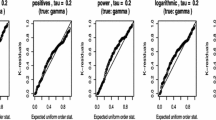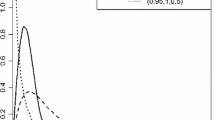Abstract
Shared frailty models are of interest when one has clustered survival data and when focus is on comparing the lifetimes within clusters and further on estimating the correlation between lifetimes from the same cluster. It is well known that the positive stable model should be preferred to the gamma model in situations where the correlated survival data show a decreasing association with time. In this paper, we devise a likelihood based estimation procedure for the positive stable shared frailty Cox model, which is expected to obtain high efficiency. The proposed estimator is provided with large sample properties and also a consistent estimator of standard errors is given. Simulation studies show that the estimation procedure is appropriate for practical use, and that it is much more efficient than a recently suggested procedure. The suggested methodology is applied to a dataset concerning time to blindness for patients with diabetic retinopathy.
Similar content being viewed by others
References
P. K. Andersen Ø. Borgan R. Gill N. Keiding (1993) Statistical Models Based on Counting Processes Springer-Verlag New York
P. K. Andersen J. P. Klein M. J. Zhang (1999) ArticleTitle“Testing for centre effects in multi-centre survival studies: A monte carlo comparison of fixed and random effects tests” Statistics in Medicine 18 1489–1500
J. P. Fine D. V. Glidden K. E. Lee (2003) ArticleTitle“A simple estimator for a shared frailty regression model” Journal of Royal Statical Society Series B 65 317–329
R. V. Foutz (1977) ArticleTitle“On the unique consistent solution to the likelihood equations” Journal of American Statistical Association 72 147–148
D. V. Glidden (2000) ArticleTitle“A two-stage estimator of the dependence parameter for the Clayton-Oakes model” Lifetime Data Analysis 6 141–156
S. T. Gross C. Huber (1987) ArticleTitle“Matched pair experiments: Cox and maximum likelihood estimation” Scandanavian Journal Statistics 14 27–41
P. Hougaard (1986) ArticleTitle“A class of multivariate failure time distributions” Biometrika 73 671–678
P. Hougaard (2000) Analysis of Multivariate Survival Data Springer-Verlag New York
W. J. Huster R. Brookmeyer S. G. Self (1989) ArticleTitle“Modelling paired survival data with covariates” Biometrics 45 145–156
E. W. Lee L. J. Wei D. A. Amato (1992) “Cox-type regression analysis for large numbers of small groups of correlated failure time observations” J. P. Klein P. K. Goel (Eds) A Survival Analysis: State of The Art Kluwer Academic Publishers Dordrecht 237–247
D. Y. Lin L. J. Wei Z. Ying (1993) ArticleTitle“Checking the Cox model with cumulative sums of martingale-based residuals” Biometrika 80 557–572
D. Y. Lin Z. Ying (2001) ArticleTitle“Semiparametric and nonparametric regression analysis of longitudinal data” Journal of American Statistics Association 96 103–113
A. K. Manatunga D. Oakes (1999) ArticleTitle“Parametric analysis for matched pair survival data” Lifetime Data Analysis 5 371–387
G. G. Nielsen R. Gill P. Andersen T. Sørensen (1992) ArticleTitle“A counting process approach to maximum likelihood estimation in frailty models” Scandanavian Journal of Statistics 19 25–43
D. Oakes (1989) ArticleTitle“Bivariate survival models induced by frailties” Journal of American Statistical Association 84 487–493
C. B. Pipper T. Martinussen (2003) ArticleTitle“A likelihood based estimating equation for the Clayton-Oakes model with marginal proportional hazards” Scandanavian Journal of Statistics 30 509–522
C. B. Pipper T. Martinussen (2004) ArticleTitle“An estimating equation for parametric shared frailty models with marginal additive hazards” Journal of Royal Statistical Society Series B 66 207–220
R. L. Prentice L. Hsu (1997) ArticleTitle“Regression on hazard ratios and cross ratios in multivariate failure time analysis” Biometrika 84 349–363
C. F. Spiekerman D. Y. Lin (1998) ArticleTitle“Marginal regression models for multivariate failure time data” Journal of American Statistical Association 93 1164–1175
A. W. Vaart Particlevan der J. A. Wellner (1996) Weak Convergence and Empirical Processes Springer-Verlag New York
S. T. Wang J. P. Klein M. L. Moeschberger (1995) ArticleTitle“Semiparametric estimation of covariate effects using the positive stable frailty model” Applied Stochastic Models and Data Analysis 11 121–133
L. J. Wei D. Y. Lin L. Weissfeld (1989) ArticleTitle“Regression analysis of multivariate incomplete failure time data by modeling marginal distributions” Journal of American Statistical Association 84 1065–1073
Author information
Authors and Affiliations
Corresponding author
Rights and permissions
About this article
Cite this article
Martinussen, T., Pipper, C.B. Estimation in the Positive Stable Shared Frailty Cox Proportional Hazards Model. Lifetime Data Anal 11, 99–115 (2005). https://doi.org/10.1007/s10985-004-5642-4
Received:
Revised:
Accepted:
Issue Date:
DOI: https://doi.org/10.1007/s10985-004-5642-4




